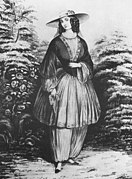Bloomers
Bloomers are very wide-cut women's pants that are gathered at the ankles.
Bloomer costume
They are part of the bloomer costume named after Amelia Bloomer , which consisted of a tightly cut top worn without a corset, a pleated skirt that ends just below the knee and trousers worn underneath. Amelia Bloomer was an American suffragette who propagated this clothing , which she initially called Turkish costume or Turkish pants , as a contribution to a reform of women's clothing from 1851 onwards.
The bloomer costume met with keen interest from representatives of women's rights, but found little practical acceptance (essentially only as part of women's sportswear, especially when cycling) and all the more mockery and ridicule. The signature of a contemporary caricature reads:
"Ms. Türk, after attending a lecture by Ms. Eich-Schmidt on emancipation clothing, immediately decides to join the new fashion, and in order to do that even more effectively, she expects Mr. Türk's support in this daring venture."
Bloomers have been cited again and again in fashion up to the present day, as Victorian attributes in Japanese Lolita fashion or Helena Bonham Carter's Bloomin 'Bloomers or with different degrees of legroom as so-called harem pants .
Bloomers also play a certain role as fetish clothing , so over the years John Willie has repeatedly dedicated articles and images to the bloomers in the magazine Bizarre, which he published .
Suffragette Lucy Stone 1853
Gymnasts wearing bloomers on the wall bars 1899
Japan
In Japan, bloomers were introduced as girls' clothing for school sports by Inokuchi Akuri in 1903, who she met while studying in Northampton and Boston . In the course of time these were first radically shortened to the base of the thigh and then also got rid of their pluderform. Since the 1990s, these clothes called Buruma ( Japanese ブ ル マ ) or Burumā ( ブ ル マgenannten ) have been replaced by sports pants . Buruma are also fetish clothes because of their association with school girls.
See also
literature
- Ingrid Loschek : Reclam's fashion and costume lexicon. Reclam, Stuttgart 1987, ISBN 3-15-010448-3 , p. 130
Web links
Individual evidence
- ↑ See Kat Jungnickel at Goldsmiths, University of London: http://bikesandbloomers.com , 2018.
- ↑ “Mrs. Turkey having attended Mrs. Oaks-Smith's Lecture on the Emancipation Dress, resolves at once to give a start to the New Fashion, and in order to do it with more Effect, she wants Mr. Turkey to join her in this bold Attempt. "
- ↑ Allen Guttmann, Lee Thompson: Japanese Sports. A history . University of Hawaii Press, 2001, ISBN 0-8248-2464-4 , pp. 93 ( limited preview in Google Book search).







